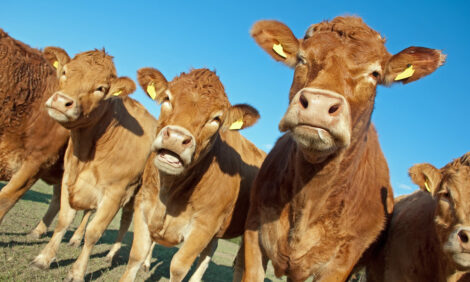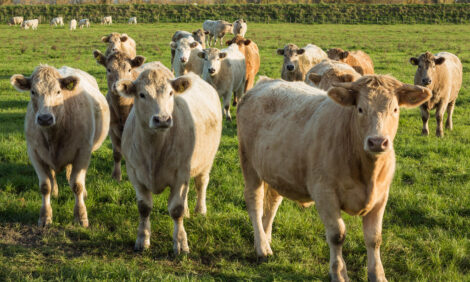



Poultry Litter Caused Botulism in Cattle, Sheep
UK - In its latest Chemical Food Safety Quarterly Report, the Veterinary Laboratories Agency reports four cases of botulism in cattle and sheep that were traced to poultry litter, and three other cases of poisoning in farm animals.In the Chemical Food Safety Quarterly Report covering the period October to December 2008, the Veterinary Laboratories Agency reports four cases of botulism in cattle and sheep that were traced to poultry litter, as well as three other cases of poisoning in cattle.
Botulism
Case 1
Botulism was suspected to be the cause of recumbency in a two-year-old dairy heifer replacement. She was the only affected heifer in a group of 60. The clinical suspicion of botulism was supported by the presence of type D botulinum toxin in the intestinal content of the affected heifer. The source was suspected to be broiler litter spread onto field adjacent to where the heifers were grazing.
Case 2
Botulism was suspected to be the cause of recumbency and death in a three-year old suckler cow. She was the first of two cows to be affected in a group of 65. The cows had been housed for a two week period whilst their calves were weaned and then let out onto a field of stubble turnips and pasture. The first case occurred one week later. The suspected source was a stack of poultry litter in the adjacent field. The litter contained poultry carcasses and was therefore in breech of the Animal By-Products Regulations. Trading Standards were informed of the breech.
Case 3
Botulism was part of the differential diagnosis during an investigation into the cause of malaise with recumbency and death in five, approximately two-year-old beef finishers. Botulism was considered to be a differential diagnosis because poultry litter was used beneath the straw bedding in the bull pens. The affected bulls were either found dead or died within 18 hours of presenting with malaise. Post mortem was carried out on two bulls. Severe pneumonia was observed from which Histophilus somnii was isolated. (This organism has been associated with pneumonia outbreaks and also with meningitis and urinary tract infections). It was considered a significant pathogen in the presentation of this disease outbreak. Type D botulinum toxin was isolated from the intestinal content of both bulls supporting concurrent exposure of the bulls to Clostridium botulinum organism and its toxin. Both botulism and Histophilus infection may have been contributing to losses in the group of cattle. The use of poultry manure as animal bedding is not illegal unless the litter contains obvious carcass material. However it is not a recommended practice because poultry litter is palatable to cattle. In addition to increasing the risk of clinical botulism, there is an increased risk of transmitting other diseases, including zoonoses such as salmonella infection.
Case 4
Botulism was suspected to be the cause of recumbency, flaccid paralysis and one death in ten sheep in a group of 300 ewes. The source of botulism was suspected to be a stack of poultry litter in the sheep grazing field which had been heavily trampled by the sheep. There were no poultry carcasses observed in the litter. The poultry litter was subsequently fenced off and the sheep moved to alternate pasture.
Other incidents
Metaldehyde toxicity
Metaldehyde toxicity was diagnosed in a group of 25 eighteen-month old dairy heifers which broke into an adjacent field where a pallet of metaldehyde pellets was waiting to be applied to a rape crop. Fourteen heifers died within a day and two further deaths occurred the following day. Nine others showed tremors and nervous signs that were exacerbated by excitement.
Oil toxicity
Oil intoxication was suspected in a group of 80 suckler cows and calves. Three cows died, each with dullness, lethargy and malaise with animals described to vocalize, become recumbent and die. Post mortem examination of one cow revealed oily non-aromatic material within the rumen. There was also abomasal ulceration and haematuria. The cattle were grazing an area of 200 acres with access to an open-fronted barn in which there were various heavy machinery, waste metal and plastic, engines and fuel containers. The disease outbreak followed the introduction of very dry haylage and freezing weather conditions which were likely to have increased the cattle's demand for fluid encouraging them to drink this oil-based fluid rather than water. None of the cattle was close to entering the food chain.
Bracken poisoning
A farm visit was carried out following the diagnosis of bracken poisoning in two, eight month old Welsh Black bullocks at necropsy. The first of these animals had a Bibersteinia trehalosi septicaemia, which was thought to be a 'one off' diagnosis. A further four deaths occurred in this group of 31 heifers and a second animal at necropsy had large infarcts in the liver and free blood in the abdominal cavity. It was at this stage that the farmer admitted that they had been fed haylage containing a large amount of bracken since they have been housed two months previously. The cause of mortality was then suspected of being bracken poisoning and haematology results from five other animals showed a significant neutropenia and thrombocytopenia, supporting the diagnosis.
Further Reading
| - | You can view the full report by clicking here. |


